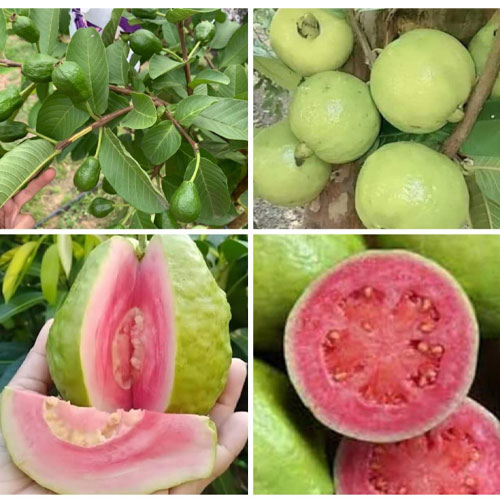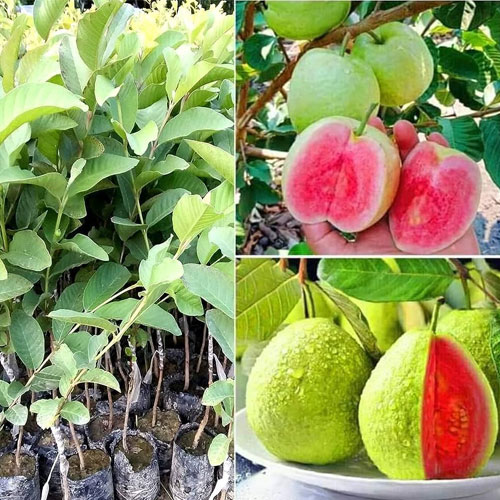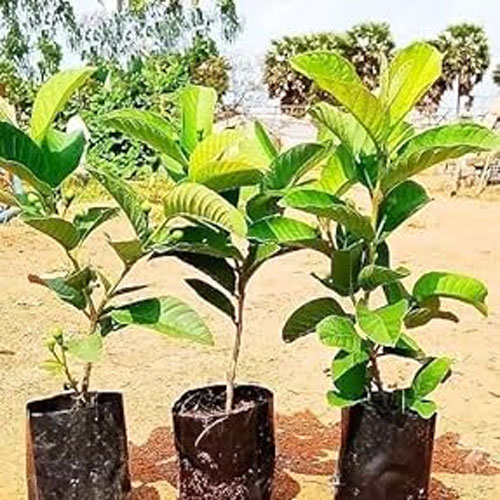Experience the tropical delight of growing your own Taiwan Pink Guava Thai All Season Live Plant. This high-yielding layered live plant produces deliciously sweet pink guavas year-round under proper care. Known for its deep pink pulp, intense aroma, and low seed content, this guava variety is perfect for home gardens, terrace pots, or small farms. A healthy, disease-resistant cultivar—sourced from original Thai varieties—this plant is your gateway to non-stop fruiting.
Type of Plant: Layered Live Fruit Plant (Non-grafted)
Fruiting Time: Starts in 8–12 months after planting
Sunlight Requirements: Full sunlight (at least 6–8 hours/day)
Where to Grow: Backyard garden, terrace pots, farm plots, balconies
Growing Season: All year-round; thrives in tropical & subtropical regions
Planting Depth: Level with the base of the rootball
Ideal Climate: Warm, humid; well-suited to Indian climates
Plant Height: 1.5 to 2 feet at delivery, grows up to 8–10 feet
Fertilizer Requirements: Organic manure, compost, bone meal every 2 months
Life Span: 15–25 years with proper maintenance
Ideal Growing Temperature: 25°C to 35°C
Fruit Harvesting Time: Every 4–5 months under ideal care
Maintenance Required: Moderate – pruning and feeding required
Watering Frequency: 2–3 times per week (adjust based on weather)
Ideal Grow Bag Size: Minimum 24×24 inch bag or large container



This Taiwan Pink Thai Guava plant can be grown year-round in most parts of India. Ideal planting is during the monsoon (June to August) or early spring (Feb–March) when temperatures are moderate and soil moisture is high. In southern states, it can be cultivated year-round. Continuous sunlight and proper feeding can lead to fruits throughout the year.
Use a sturdy grow bag or clay pot (minimum 24-inch diameter) with good drainage. Mix red soil, compost, and cocopeat in equal parts. Place the plant where it gets full sun. Support with a bamboo stake initially. Water when the topsoil feels dry, and apply neem cake monthly to prevent pests.
Preparation: Choose a sunny, well-drained location.
Transplanting: Carefully place the plant into a pit or pot without disturbing the rootball.
Watering: Water deeply after planting and repeat every 3 days during the first 2 weeks.
Mulching: Add dry leaves or straw at the base to retain moisture.
Pruning: Trim lower suckers and shape after each fruiting cycle.
Sunlight: Requires full sun (minimum 6 hrs/day)
Soil: Well-drained sandy loam or red soil with pH 6–7
Fertilization: Apply compost, vermicompost, and NPK every 60 days
Pruning: Trim after fruit harvest to encourage new shoots
Spacing: Keep at least 6 ft from other trees for air circulation
Pest Control: Neem oil spray every 2 weeks prevents mealybugs & borers
Disease Prevention: Ensure drainage; copper fungicide if fungal rot appears
Mulching: Retains moisture and suppresses weeds
Harvesting: Pick fruits when slightly yellow and aromatic for best taste
1. Apply Nutrient-Rich Fertilizers
When your plants begin flowering, use nutrient-rich fertilizers like Organic Bone Meal Powder or Vermicompost. This helps in boosting the bloom and enhances overall yield.
2. Use Organic Fertilizers
Feed your plants with organic fertilizers such as Cow Dung Manure or Neem Cake. Organic options promote healthy soil life.
3. Regular Feeding
Apply fertilizers every 20-25 days to ensure plants receive a steady supply of nutrients. Choose from various options like Cocopeat Compost for moisture retention.
All-Season Fruiting: Bears fruit multiple times a year
Exotic Thai Variety: Authentic sweet pink flesh with minimal seeds
Great for Containers: Can be grown easily on terraces and balconies
Delicious & Nutritious: Rich in Vitamin C, fiber, and antioxidants
Low Maintenance: Easy to grow even for beginners
High Market Demand: Profitable fruit with good shelf life
Fragrant Fruits: Strong tropical aroma when ripe
Rich Source of Vitamin C – Boosts immunity naturally
Low in Calories, High in Fiber – Great for digestive health
Ideal for Juices, Pickles & Desserts
Acts as a Natural Antioxidant – Promotes skin health
Perfect for Children & Adults – Sweet, soft, and non-acidic
Commercial Potential – High-yielding variety preferred by growers
Do not overwater – soggy soil can cause root rot
Protect from frost or extreme cold using mulch or temporary cover
Avoid excessive nitrogen-rich fertilizers; promotes leaves over fruits
Check for pests regularly – mealybugs and fruit flies may appear
Stake young plants to prevent wind damage
Yellowing Leaves – Caused by poor drainage or lack of nutrients. Fix with compost and proper watering.
Fruit Cracking – Prevent by watering evenly and mulching during fruit development.
No Fruiting – Check for sunlight, pruning, and age (may start late fruiting if rootbound in pot).
Aphids or Mealybugs – Use neem oil + soap spray every 10–15 days.
Taiwan Pink Guava, Thai Guava, Thai Pink Guava, Seemai Guava, Roja Koyya, Pink Amrud, Thai Peru, Thai Guava All Time Variety, Exotic Pink Guava, Guava Fruit Plant
Q1: Is this guava variety seedless?
It has very few soft seeds – almost melt-in-mouth texture.
Q2: When will the plant start fruiting?
It begins fruiting within 8–12 months with proper care.
Q3: Can it be grown on a terrace?
Yes! Use a 24-inch grow bag or drum for best results.
Q4: What makes it “all-time”?
It can produce fruits multiple times a year under good sunlight and care.
Sign in now to receive a 5% instant discount on your first order when using code WELCOME. Begin your organic journey today!
By logging in, you're agreeing to our Terms of Service and Privacy Policy.
Oviya
Golden Hills Farm se plant lena hamesha worth hota hai.
Himani
Taiwan Pink Guava Thai All-Season Live Plant fresh aur healthy condition me mila.
Divya
Bahut sundar variety hai, taste aur aroma dono amazing hain.
Gaurav
Plant bahut fast grow kar raha hai terrace garden me.
Sanya
Bahut accha packaging tha aur delivery time par hui.
Fatima
Fruits juicy aur sweet taste ke hote hain, very satisfying.
Lalita
Bahut unique variety hai, har season me fruit milta hai.
Deepa
Plant ekdum disease-free aur lush green mila.
Renu
Plant transplant karte hi new growth shuru ho gayi.
Jagdish
Bahut accha result diya, green aur vibrant leaves aa gaye.